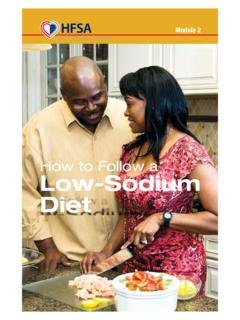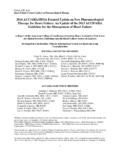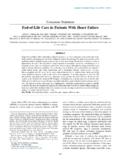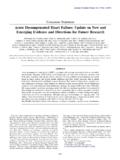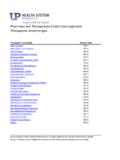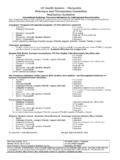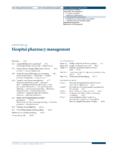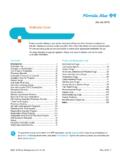Transcription of 2016 ACC/AHA/HFSA Focused Update on New …
1 Guidelines2016 ACC/AHA/HFSA Focused Update on New PharmacologicalTherapy for Heart Failure: An Update of the 2013 ACCF/AHAG uideline for the Management of Heart FailureA Report of the American College of Cardiology/American HeartAssociation Task Force on Clinical Practice Guidelines and the HeartFailure Society of AmericaDeveloped in Collaboration With the American College of Chest Physicians and International Societyfor Heart and Lung TransplantationWRITING COMMITTEE MEMBERS*Clyde W. Yancy, MD, MSc, MACC, FAHA, FHFSA, Chair,Mariell Jessup, MD, FACC, FAHA, FESC, Vice Chair,Biykem Bozkurt, MD, PhD, FACC, FAHA,*, Javed Butler, MD, MBA, MPH, FACC, FAHA,*, Donald E. CaseyJr, MD, MPH, MBA, FACC, Monica M. Colvin, MD, FAHA, Mark H. Drazner, MD, MSc, FACC, FAHA, Gerasimos Filippatos, MD, FESC,*Gregg C. Fonarow, MD, FACC, FAHA, FHFSA,*, Michael M. Givertz, MD, FACC, FHFSA,*, Steven M. Hollenberg, MD, FACC,#JoAnn Lindenfeld, MD, FACC, FAHA, FHFSA,*, Frederick A.
2 Masoudi, MD, MSPH, FACC,**Patrick E. McBride, MD, MPH, FACC, Pamela N. Peterson, MD, FACC, Lynne Warner Stevenson, MD, FACC,*, ANDC heryl Westlake, PhD, RN, ACNS-BC, FHFSA ACC/AHA TASK FORCE MEMBERSJ onathan L. Halperin, MD, FACC, FAHA, Chair,Glenn N. Levine, MD, FACC, FAHA, Chair-Elect,Sana M. Al-Khatib, MD, MHS, FACC, FAHA,Kim K. Birtcher, PharmD, MS, AACC,Biykem Bozkurt, MD, PhD, FACC, FAHA,Ralph G. Brindis, MD, MPH, MACC,Joaquin E. Cigarroa, MD, FACC,Lesley H. Curtis, PhD, FAHA,Lee A. Fleisher, MD, FACC, FAHA,Federico Gentile, MD, FACC,Samuel Gidding, MD, FAHA,Mark A. Hlatky, MD, FACC,John Ikonomidis, MD, PhD, FAHA,Jos Joglar, MD, FACC, FAHA,Susan J. Pressler, PhD, RN, FAHA, ANDD uminda N. Wijeysundera, MD, PhDKey Words:AHA Scientific Statements, angioedema, angiotensin-converting enzyme inhibitors, angiotensinreceptor blockers, angiotensin receptor-neprilysin inhibitor, beta blockers, Focused Update , heart failure,ivabradine, natriuretic document was approved by the American College of CardiologyBoard of Trustees and Executive Committee, the American Heart Associa-tion Science Advisory and Coordinating Committee and Executive Committee,and the Heart Failure Society of America Executive Committee in Heart Failure Society of America requests that this document be citedas follows: Yancy CW, Jessup M, Bozkurt B, Butler J, Casey DE Jr, ColvinMM, Drazner MH, Filippatos G, Fonarow GC, Givertz MM, Hollenberg SM,Lindenfeld J, Masoudi FA, McBride PE, Peterson PN, Stevenson LW, West-lake C.
3 2016 ACC/AHA/HFSA Focused Update on new pharmacologicaltherapy for heart failure: an Update of the 2013 ACCF/AHA guideline forthe management of heart failure: a report of the American College ofCardiology/American Heart Association Task Force on Clinical Practice Guide-lines and the Heart Failure Society of Cardiac Fail2016;22:659 article has been copublished in theJournal of the American Collegeof Cardiology and : This document is available on the World Wide Web sites of theAmerican College of Cardiology ( ), the American Heart As-sociation ( ), and the Heart Failure Society of America( ). For copies of this document, please contact Elsevier IncReprint Department, fax (212) 633-3820 or peer review of AHA Scientific Statements is conducted by theAHA Office of Science Operations. For more on AHA statements andguidelines development, Selectthe Guidelines & Statements drop-down menu, then click PublicationDevelopment.
4 Permissions: Multiple copies, modification, alteration, en-hancement, and/or distribution of this document are not permitted withoutthe express permission of the American Heart Association. Requests maybe completed online via the Elsevier site ( ).*Writing committee members are required to recuse themselves from votingon sections to which their specific relationships with industry may apply;seeAppendix 1for detailed information. ACC/AHA Task Force on Clinical Practice Guidelines Liaison. ACC/AHA Representative. ACP Representative. ISHLT Representative. HFSA Representative.#CHEST Representative.**ACC/AHA Task Force on Performance Measures Representative. AAFP $ - see front of Cardiac Failure Vol. 22 No. 9 2016 PreambleIncorporation of new study results, medications, or devicesthat merit modification of existing clinical practice guidelinerecommendations, or the addition of new recommendations,is critical to ensuring that guidelines reflect current knowl-edge, available treatment options, and optimum medical keep pace with evolving evidence, the American Collegeof Cardiology (ACC)/American Heart Association (AHA) TaskForce on Clinical Practice Guidelines ( Task Force ) has issuedthis Focused Update to reassess guideline recommendationson the basis of recently published study data.
5 This Update hasbeen subject to rigorous, multilevel review and approval, similarto the full guidelines. For specific Focused Update criteria andadditional methodological details, please see the ACC/AHAguideline methodology have evolved over time in response to pub-lished reports from the Institute of Medicine2,3and ACC/AHA mandates,4 7leading to adoption of a knowledgebyte format. This process entails delineation of a recom-mendation addressing a specific clinical question, followedby concise text (ideally<250 words) and hyperlinked tosupportive evidence. This approach better accommodatestime constraints on busy clinicians, facilitates easier accessto recommendations via electronic search engines and otherevolving technology, and supports the evolution of guide-lines as living documents that can be dynamically updatedas Evaluation and ManagementThe termguideline-directed evaluation and management(GDEM) refers to care defined mainly by ACC/AHA ClassI recommendations.
6 For these and all recommended drugtreatment regimens, the reader should confirm dosage withproduct insert material and carefully evaluate forcontraindications and interactions. Recommendations arelimited to treatments, drugs, and devices approved forclinical use in the United of Recommendation and Level of EvidenceThe Class of Recommendation (COR) and Level ofEvidence (LOE) are derived independently of each otheraccording to established criteria. The COR indicates thestrength of recommendation, encompassing the estimatedmagnitude and certainty of benefit of a clinical action inproportion to risk. The LOE rates the quality of scientificevidence supporting the intervention on the basis of thetype, quantity, and consistency of data from clinical trialsand other sources (Table 1). Recommendations in thisfocused Update reflect the new 2015 COR/LOE system, inwhich LOE B and C are subcategorized for the purpose ofincreased ,5,8 Relationships With Industry and Other EntitiesThe ACC and AHA exclusively sponsor the work of guide-line writing committees without commercial support, andmembers volunteer time for this activity.
7 Selected organiza-tions and professional societies with related interests and expertiseare invited to participate as partners or collaborators. The TaskForce makes every effort to avoid actual, potential, or per-ceived conflicts of interest that might arise through relationshipswith industry or other entities (RWI). All writing committeemembers and reviewers are required to fully disclose currentindustry relationships or personal interests, beginning 12 monthsbefore initiation of the writing effort. Management of RWI in-volves selecting a balanced writing committee and requires thatboth the chair and a majority of writing committee membershave no relevant RWI (seeAppendix 1for the definition ofrel-evance). Members are restricted with regard to writing or votingon sections to which RWI apply. Members of the writing com-mittee who recused themselves from voting are indicated andspecific section recusals are noted inAppendix 1.
8 In addition,for transparency, members comprehensive disclosure infor-mation is available asAppendix S1, and reviewers RWIdisclosures are included inAppendix 2. Comprehensive dis-closure information for the Task Force is also available The Task Forcestrives to avoid bias by selecting experts from a broad array ofbackgrounds representing different geographic regions, genders,ethnicities, intellectual perspectives, and scopes of UseGuidelines provide recommendations applicable to patientswith or at risk of developing cardiovascular disease. The focusis on medical practice in the United States, but guidelines de-veloped in collaboration with other organizations may have abroader target. Although guidelines may be used to inform reg-ulatory or payer decisions, the intent is to improve quality ofcare and align with patients interests. The guidelines are re-viewed annually by the Task Force and are official policy ofthe ACC and AHA.
9 Each guideline is considered current unlessand until it is updated, revised, or superseded by a IssuesFor additional information pertaining to the methodologyfor grading evidence, assessment of benefit and harm, shareddecision making between the patient and clinician, structureof evidence tables and summaries, standardized terminologyfor articulating recommendations, organizational involve-ment, peer review, and policies regarding periodic assessment660 Journal of Cardiac Failure Vol. 22 No. 9 September 2016and updating of guideline documents, we encourage readersto consult the ACC/AHA guideline methodology L. Halperin, MD, FACC, FAHAC hair, ACC/AHA Task Force on Clinical Practice GuidelinesIntroductionThe ACC, the AHA, and the Heart Failure Society of America(HFSA) recognize that the introduction of effective new thera-pies that potentially affect a large number of patients presentsboth opportunities and challenges.
10 The introduction of an an-giotensin receptor neprilysin inhibitor (ARNI) (valsartan/sacubitril) and a sinoatrial node modulator (ivabradine), whenapplied judiciously, complements established pharmacologicaland device-based therapies and represents a milestone in theevolution of care for patients with heart failure (HF). Accord-ingly, the writing committees of the 2016 ACC/AHA/HFSAF ocused Update on New Pharmacological Therapy for HeartFailure and the 2016 ESC Guideline on the Diagnosis andTreatment of Acute and Chronic Heart Failure concurrentlydeveloped recommendations for the incorporation of these thera-pies into clinical practice. Working independently, each writingcommittee surveyed the evidence, arrived at similar conclu-sions, and constructed similar, but not identical, the concordance, the respective organizations simulta-neously issued aligned recommendations on the use of thesenew treatments to minimize confusion and improve the care ofpatients with of the ACC/AHA/HFSA writing committee withoutrelevant RWI voted on the final recommendations.
